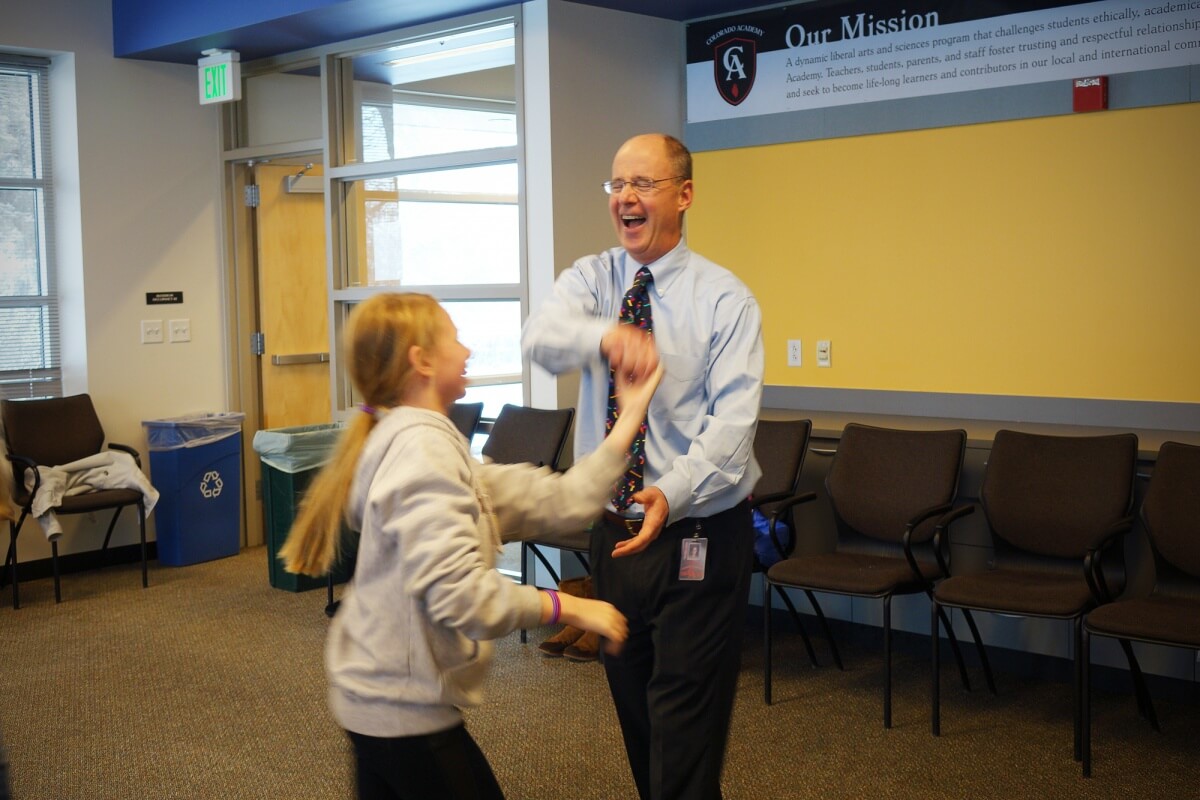“Just one basic to start, and then an inside turn,” says long-time Middle School teacher Jim Milavec to a room full of students. “Okay 5,6,7,8, triple, triple, back; inside turn.” Repeating the sequence, his voice fades into the background as students look down at their feet to mimic the instruction.
In his 37 years at CA, teaching swing dance is a far cry from the science that Milavec is used to. As for the Middle School teacher’s success — that seems clear when the students come to a stop. There’s a momentary silence, quickly swallowed up by yelps and high-fives as they celebrate along with the volunteers.
But the volunteers aren’t Middle School students, though Upper School Librarian Jen Reading concedes that she must be turning into one as she joins her partner in jumping up and down while yelling, “We did it!” Instead, they’re all a part of the Middle School Swing Dance Club, and it’s unclear as to who’s having more fun here: the students or the volunteers — teachers such as Reading, and Middle School Math teacher Jason Koza, as well as Middle School Spanish teacher Sara Monterroso. Others drop in to take a spin: Director of Inclusivity Adrian Green and Middle School Principal Bill Wolf-Tinsman.
“It’s unclear as to who’s having more fun here: the students or the volunteers.”
“I think swing dancing is just something that kids enjoy and it’s starting to come back,” says Milavec. “I mentioned it to the kids and they seemed to be interested. Twenty-six signed up for the club, ten of whom were boys, which I thought was highly unusual.”
The Swing Dance Club meets on “B” days for 35 minutes for a total of six classes, and Milavec, who started learning the dance to appease his wife, says that — like his wife — he had to give the boys a little push to join in.
Boys like eighth grader Adam Dorsheimer, who says with a shrug: “My favorite teacher was hosting it and he wanted guys to do it, so I joined.”
 As to whether or not Dorsheimer is having fun, the answer might surprise you. Not because it’s a yes, but because it’s an emphatic one. “It’s really fun,” he says, suddenly lighting up. “I didn’t expect to enjoy it this much.”
As to whether or not Dorsheimer is having fun, the answer might surprise you. Not because it’s a yes, but because it’s an emphatic one. “It’s really fun,” he says, suddenly lighting up. “I didn’t expect to enjoy it this much.”
That sentiment seems to engulf the room as students and teachers celebrate their success. It’s actually overwhelming, which might be why research suggests this type of cooperative learning — students working together instead of individualistically or competitively — produces positivity about subject areas, teachers and each other. Or it could simply be what Brazilian author Paulo Coelho wrote in The Witch Of Portobello: “When you dance, you can enjoy the luxury of being you.”
“They’re having fun. They’re interested. They’re feeling success,” says Milavec more succinctly. And the teachers are enjoying it, too, partially because it allows them to learn right along with the students.
“Learning alongside the students gives me the opportunity to see the kids in a different light,” says Reading. “They are a spirited bunch.”
In the background “Kansas City,” a popular swing song, cues up over the iPod speaker and boys set aside being bashful to take their partner’s hand. Dancing in time with the song, the students plan to debut their skills at the upcoming Middle School dance.
After class, Milavec laces up his shoes. The lightness that filled the room moments before still lingers in his voice and in the upturned corners of his mouth. He adds one last thought before going back to the classroom. “I’m hoping that next year,” he says with a wry smile, “there’s another Swing Dance Club for them.” As to whether he’s referring to the students, the teachers, or both, he doesn’t say.
